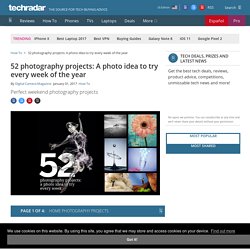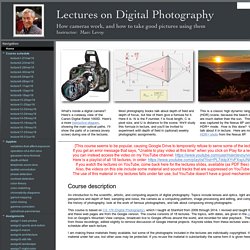

Best of Photojournalism: What Makes a Winner. Free Digital Photography Courses, Lessons, and Tutorials. HomeBeginner Photography Course Overview – Syllabus Our beginner photography classes are created to be quick and easy to understand for beginner photographers – even those that feel they are beyond help of being able to understand their camera.

Our lessons will help you understand the basics of light and how your eye fixes lighting. How to get your camera to catch what your eye sees to produce better pictures. The tutorials will also help you understand your camera and how to take pictures with it. Lesson 1: Light & The Photographer In this lesson we look at light, the primary tool for the photographer Lesson 2: Light and the Human Eye It’s fascinating to learn how the human eye processes light!
Lesson 3: Photographic Lenses This lesson will cover a basic discussion of lenses and some good tips on lens use and care. Lesson 4: Exposure Control Understanding exposure is fundamental to photography Lesson 5: ISO Camera Setting Lesson 6: Shutter Speed Settings Hate blurry photographs? Goals. The Bastards Book of Photography by Dan Nguyen. Cambridge in Colour - Photography Tutorials & Learning Community. 52 photography projects: A photo idea to try every week of the year. Taking on a photography project is a great way to get yourself out of a photography rut and to bring some focus to your picture-taking.

Placing some constraints on what you're going to take photos of or what camera gear you'll use really does force you to become more creative, too. We've prepared 52 fantastic photo ideas - one for every week in 2017. These are split into three sections: easy home projects you can do today, ideas you can try outdoors at the weekend and a series of ongoing photo projects that you can start now but keep topping up in the coming weeks and months.
Home photography projects 1. The basic idea with this project is to suspend a container of liquid and let drops fall through a small hole, then capture the resulting splash. 2. For this project you'll need a flashgun that you can fire remotely, a container with clear sides for your water, a coloured background and a tripod. 3. Smoke trails are a firm favourite among still-life photographers. 4. 5. 6. Make Your Own Photogram Cyanotype. If you are not familiar with photograms and cyanotypes, here are two new words for you: A Photogram is a photograph made without a camera by placing objects directly onto a photographic paper.

A Cyanotype is the developing process used to make blue prints. You can have lots of fun and interesting results by creating Cyanotype Photograms. Photographer Paul Eliasberg is going to show us how. At college our last assignment was ‘portraiture’ and our piece had to be tied in with an art movement. I decided on Dada and Man Ray and of course using a photogram or “Rayograph” as Man Ray liked to call them. When you do a bit of reading up and take a bit of care, making cyanotype prints is an extremely easy but incredibly rewarding process: you coat a piece of paper with a solution, expose it to UV light covered by either a negative or objects, wash it out and presto, you’ve got a print. Watercolor Paper. Digital Photography.
An introduction to the scientific, artistic, and computing aspects of digital photography.

Topics include lenses and optics, light and sensors, optical effects in nature, perspective and depth of field, sampling and noise, the camera as a computing platform, image processing and editing, and computational photography. We will also survey the history of photography, look at the work of famous photographers, and talk about composing strong photographs. This course is based on CS 178 (Digital Photography), which I taught at Stanford from 2009 through 2014. I revised and taught the course again at Google in Spring of 2016, and these web pages are from the Google version. The course consists of 18 lectures. I am making these materials freely available, but some of the photographs included in the lectures are individually copyrighted.
The course assumes no prior knowledge of photography. Taking photographs and improving your picture-taking skills are a good reason for taking this course.